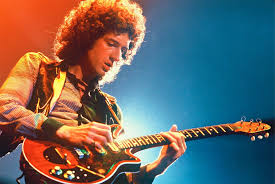How Hendrix and Clapton Shaped Brian May’s Guitar Genius
Before becoming Queen’s legendary guitarist, Brian May’s musical world was rooted in rhythm and melody. In the early 1960s, inspired by the Everly Brothers, Elvis Presley, and the Shadows, May focused on crafting clean, song-centered guitar lines rather than the explosive lead work that was beginning to redefine rock.

Everything shifted around 1965. Eric Clapton and Jeff Beck arrived on the London scene, and their mastery of blues and innovation left an indelible mark on May. “Clapton was unbelievable, just so sparkling and fluid,” May recalled. Watching Clapton with the Yardbirds reignited May’s fascination with blues greats like B.B. King and Bo Diddley and pushed him toward a serious exploration of rock and blues techniques beyond the melodic confines of the Shadows.
Beck’s performances were equally transformative. May remembered being mesmerized: “I couldn’t believe what he could do… He made feedback into music and played entire tunes without even touching the fingerboard.” Seeing Beck wield the guitar in such unprecedented ways introduced May to the possibilities of the instrument, while an impromptu jam with Clapton at London’s Marquee Club became a memory that would influence his approach for years.

Yet it was Jimi Hendrix who truly redefined May’s understanding of guitar. After witnessing Clapton and Beck, May thought he had seen the pinnacle of guitar artistry—until Hendrix arrived. “Oh, my God. This guy is doing everything that I was trying to do. He just made me feel like I couldn’t play,” May admitted. Hendrix’s ability to make the guitar “talk,” to convey emotion as if it were a voice, was unlike anything May had seen. Initially skeptical, May wondered if Hendrix’s dazzling solos, like those on Hey Joe and Stone Free, were studio tricks—until a live performance supporting The Who at London’s Savoy Theatre left him awestruck. “The Who couldn’t follow him in those days,” he said. “Anybody in the world would find it hard to follow Hendrix.”
This humbling experience was not unique to May. Pete Townshend of The Who also admitted that Hendrix’s arrival shook his confidence, yet the challenge ultimately pushed him to innovate, culminating in groundbreaking works like Tommy. For May, these encounters with extraordinary talent became catalysts for his own evolution.
Other influences helped shape May’s distinctive sound. Guitarist Rory Gallagher introduced him to gear that would define Queen’s signature tone, including the Vox AC30 amplifier and Dallas Rangemaster Treble Booster. Coupled with his melodic sensibility, these tools allowed May to develop a guitar style uniquely his own—simultaneously technical, expressive, and instantly recognizable.
Looking back, Brian May’s journey illustrates a universal truth for musicians: witnessing greatness can humble, challenge, and ultimately elevate one’s own artistry. The awe inspired by Clapton, Beck, and Hendrix didn’t discourage May—it fueled him, guiding him toward a voice that could stand among the giants while remaining distinctly his.
Through admiration, emulation, and fearless exploration, May transformed the lessons of his heroes into a legacy that continues to inspire. It is a testament to the power of influence: sometimes, to find your own voice, you must first be humbled by the extraordinary.




